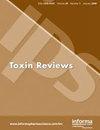蝎毒透明质酸酶研究进展;异构体、表达与系统发育
IF 2.4
4区 医学
Q2 TOXICOLOGY
引用次数: 4
摘要
摘要毒液透明质酸酶是糖苷水解酶家族的一种酶,通过在组织中传播毒素和破坏细胞外基质,在系统环境形成中发挥着关键作用。毒液透明质酸酶在环境形成过程中的作用已被广泛研究,但其变体和异构体的鉴定仍在研究中。在本研究中,我们开发了一种过滤方法,使用RNA-seq技术来鉴定厚尾蝎和扁尾蝎的外显子-内含子模式、选择性剪接事件和透明质酸酶异构体。此外,进行了计算机分析以鉴定和表征透明质酸酶。最重要的发现是蝎透明质酸酶基因包含5个外显子和4个内含子,并经历选择性剪接事件。在A.crassicauda和H.lepturus数据集中,一个命名为AcHase-1的序列和三个命名为HLHase1、HLHase2和HLHase3的序列分别被鉴定为透明质酸酶变体,发现它们具有在编码、非编码或未翻译区域不同的多个亚型。结果表明,外显子跳跃、内含子保留和选择性3’剪接位点导致基因表达失调。为了在透明质酸酶分子系统发育研究的基础上阐明蝎子的进化史,我们使用系统发育树来推断这种蛋白质在不同种类的蝎子、蜘蛛和蜜蜂中的起源。透明质酸酶基因在分化方面表现良好,并准确地分离出亲缘关系密切的物种。我们的工作为蝎子进化过程中Hase蛋白的多样性提供了见解,并可能指导进一步的研究,包括合成、纯化和重组生产Hase蛋白。本文章由计算机程序翻译,如有差异,请以英文原文为准。
New insights about scorpion venom hyaluronidase; isoforms, expression and phylogeny
Abstract Venom hyaluronidase is an enzyme belonging to the glycoside hydrolase family that plays a critical role in systemic envenomation by spreading toxins in tissue and destruction of the extracellular matrix. The roles of venom hyaluronidase during envenomation have been widely studied, but the identification of its variants and isoforms is still under investigation. In this study, we developed a filtering method to identify the exon-intron pattern, alternative splicing events and isoforms of hyaluronidase in A. crassicauda and H. lepturus scorpions using the RNA-seq technique. Furthermore, in silico analysis was performed to identify and characterize the hyaluronidases. The most important findings were that the scorpion hyaluronidase gene contains 5 exons, 4 introns and undergo to alternative splicing events. In A. crassicauda and H. lepturus datasets, a sequence denominated AcHase-1 and three denominated HLHase1, HLHase2 and HLHase3 were identified as hyaluronidase variants respectively, which were found to have multiple isoforms that differed in the coding, non-coding or untranslated regions. The results showed that exon skipping, intron retention and alternative 3' splice site led to dysregulation of gene expression. To clarify the evolutionary history of scorpions based on hyaluronidase molecular phylogenetic studies, we used the phylogenetic tree to deduce the origins of this protein in different species of scorpions, spiders and bees. Hyaluronidase gene performed well for divergences and accurately separated closely related species. Our work provides insights into the diversity of Hase proteins during scorpion evolution and may direct further studies consisting of synthesis, purification and recombinant production of Hase proteins.
求助全文
通过发布文献求助,成功后即可免费获取论文全文。
去求助
来源期刊

Toxin Reviews
医学-毒理学
CiteScore
6.80
自引率
0.00%
发文量
36
审稿时长
>12 weeks
期刊介绍:
Toxin Reviews provides an international forum for publishing state-of-the-art reviews and guest-edited single topic special issues covering the multidisciplinary research in the area of toxins derived from animals, plants and microorganisms. Our aim is to publish reviews that are of broad interest and importance to the toxinology as well as other life science communities. Toxin Reviews aims to encourage scientists to highlight the contribution of toxins as research tools in deciphering molecular and cellular mechanisms, and as prototypes of therapeutic agents. Reviews should emphasize the role of toxins in enhancing our fundamental understanding of life sciences, protein chemistry, structural biology, pharmacology, clinical toxinology and evolution. Prominence will be given to reviews that propose new ideas or approaches and further the knowledge of toxinology.
 求助内容:
求助内容: 应助结果提醒方式:
应助结果提醒方式:


